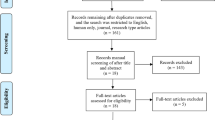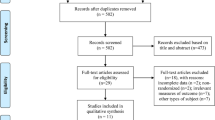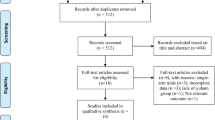Abstract
Background
Previous meta-analyses did not explore the immediate and long-term effect of non-invasive brain stimulation (NIBS) on different cognitive domains in Alzheimer’s disease (AD). The meta-analysis aimed to assess the therapy effect of repetitive transcranial magnetic stimulation (rTMS) and transcranial direct current stimulation (tDCS) on different cognitive domains in AD in randomized controlled trials (RCTs).
Methods
Studies published before December 2021 and exploring therapy effect of rTMS, tDCS on different cognitive domains in AD were searched in the following databases: PubMed and Web of Science. We used STATA 12.0 software to compute the standard mean difference (SMD) and a 95% confidence interval (CI).
Results
The present study included 16 articles (including 372 AD patients treated with rTMS and 310 treated with sham rTMS) for rTMS and 11 articles (including 152 AD patients treated with tDCS and 134 treated with sham tDCS) for tDCS. The present study showed better immediate and long-term general cognitive function increase effects in AD given rTMS, compared to those given sham rTMS with random effects models (immediate effect: SMD = 2.07, 95% CI = 0.37 to 3.77, I2 = 97.8%, p < 0.001; long-term effect: SMD = 5.04, 95% CI = 2.25 to 7.84, I2 = 97.8%, p < 0.001). The present study showed no significant immediate and long-term effects of rTMS on attention, executive, language and memory functions. In addition, the present study showed no significant difference in immediate or long-term effects of tDCS on general cognitive function, attention, language or memory functions between tDCS group and sham tDCS group.
Conclusions
RTMS was an effective treatment technique for general cognitive function in AD, whereas tDCS showed no significant therapy effect on cognitive function in AD. More large-scale studies were essential to explore the effect of NIBS on various cognitive function in AD.





Similar content being viewed by others
References
Fargo KN, Aisen P, Albert M, Au R, Corrada MM, DeKosky S, Drachman D, Fillit H, Gitlin L, Haas M, Herrup K, Kawas C, Khachaturian AS, Khachaturian ZS, Klunk W, Knopman D, Kukull WA, Lamb B, Logsdon RG, Maruff P, Mesulam M, Mobley W, Mohs R, Morgan D, Nixon RA, Paul S, Petersen R, Plassman B, Potter W, Reiman E, Reisberg B, Sano M, Schindler R, Schneider LS, Snyder PJ, Sperling RA, Yaffe K, Bain LJ, Thies WH, Carrillo MC. 2014 Report on the Milestones for the US National Plan to Address Alzheimer’s Disease. Alzheimers Dement 2014;10, eS430–452; doi: https://doi.org/10.1016/j.jalz.2014.08.103.
Weuve J, Hebert LE, Scherr PA, Evans DA. Deaths in the United States among persons with Alzheimer’s disease (2010–2050). Alzheimers Dement 2014;10, ee40–46; doi: https://doi.org/10.1016/j.jalz.2014.01.004.
Briggs R, Kennelly SP, O’Neill D. Drug treatments in Alzheimer’s disease. Clin Med (Lond) 2016;16, e247–253; doi: https://doi.org/10.7861/clinmedidne.16-3-247.
Salomone S, Caraci F, Leggio GM, Fedotova J, Drago F. New pharmacological strategies for treatment of Alzheimer’s disease: focus on disease modifying drugs. Br J Clin Pharmacol 2012;73, e504–51; doi: https://doi.org/10.1111/j.1365-2125.2011.04134.x.
Ni Z, Chen R. Transcranial magnetic stimulation to understand pathophysiology and as potential treatment for neurodegenerative diseases. Transl Neurodegener 2015;4, e22; doi: https://doi.org/10.1186/s40035-015-0045-x.
Lin Y, Jiang WJ, Shan PY, Lu M, Wang T, Li RH, Zhang N, Ma L. The role of repetitive transcranial magnetic stimulation (rTMS) in the treatment of cognitive impairment in patients with Alzheimer’s disease: A systematic review and meta-analysis. J Neurol Sci 2019 398, 184–191; doi: https://doi.org/10.1016/j.jns.2019.01.038.
Saxena V, Pal A. Role of Transcranial Direct Current Stimulation in the Management of Alzheimer’s Disease: A Meta-analysis of Effects, Adherence and Adverse Effects. 2021;19, 589–599; doi: https://doi.org/10.9758/cpn.2021.19.4.589.
Cai M, Guo Z, Xing G, Peng H, Zhou L, Chen H, McClure MA, He L, Xiong L, He B, Du F, Mu Q. Transcranial Direct Current Stimulation Improves Cognitive Function in Mild to Moderate Alzheimer Disease: A Meta-Analysis. Alzheimer Dis Assoc Disord 2019;33, e170–178; doi: https://doi.org/10.1097/WAD.0000000000000304.
Chou YH, Ton That V, Sundman M. A systematic review and meta-analysis of rTMS effects on cognitive enhancement in mild cognitive impairment and Alzheimer’s disease. Neurobiol Aging 2020;86, 1–10; https://doi.org/10.1016/j.neurobiolaging.2019.08.020.
Cruz Gonzalez P, Fong KNK, Chung RCK, Ting KH, Law LLF, Brown T. Can Transcranial Direct-Current Stimulation Alone or Combined With Cognitive Training Be Used as a Clinical Intervention to Improve Cognitive Functioning in Persons With Mild Cognitive Impairment and Dementia? A Systematic Review and Meta-Analysis. Front Hum Neurosci 2018;12, e416; doi: https://doi.org/10.3389/fnhum.2018.00416.
Petersen RC, Smith GE, Waring SC, Ivnik RJ, Tangalos EG, Kokmen E. Mild cognitive impairment: clinical characterization and outcome. Arch Neurol 1999;56, e303–308; doi: https://doi.org/10.1001/archneur.56.3.303.
Moher D, Liberati A, Tetzlaff J, Altman DG. Preferred reporting items for systematic reviews and meta-analyses: the PRISMA statement. Bmj 339, b2535; doi: https://doi.org/10.1371/journal.pmed.1000097.
Lezak MD. Neuropsychological assessment (3rd ed.). Journal of Neurology Neurosurgery & Psychiatry 2009;58, e655–664; doi: https://doi.org/10.1136/jnnp.58.6.655.
Cotelli M, Calabria M, Manenti R, Rosini S, Zanetti O, Cappa SF, Miniussi C. Improved language performance in Alzheimer disease following brain stimulation. J Neurol Neurosurg Psychiatry 2011. 82, 794–797; doi: https://doi.org/10.1136/jnnp.2009.197848.
Ahmed MA, Darwish ES, Khedr EM, El Serogy YM, Ali AM. Effects of low versus high frequencies of repetitive transcranial magnetic stimulation on cognitive function and cortical excitability in Alzheimer’s dementia. J Neurol 2012;259, e83–92; doi: https://doi.org/10.1007/s00415-011-6128-4.
Rabey JM, Dobronevsky E, Aichenbaum S, Gonen O, Marton RG, Khaigrekht M. Repetitive transcranial magnetic stimulation combined with cognitive training is a safe and effective modality for the treatment of Alzheimer’s disease: a randomized, double-blind study. J Neural Transm (Vienna) 2013;120, e813–819; doi: https://doi.org/10.1007/s00702-012-0902-z.
Eliasova I, Anderkova L, Marecek R, Rektorova I. Non-invasive brain stimulation of the right inferior frontal gyrus may improve attention in early Alzheimer’s disease: a pilot study. J Neurol Sci 2014;346, e318–322; doi: https://doi.org/10.1016/j.jns.2014.08.036.
Rutherford G, Lithgow B, Moussavi Z. Short and Long-term Effects of rTMS Treatment on Alzheimer’s Disease at Different Stages: A Pilot Study. J Exp Neurosci 2015;9, e43–51; doi: https://doi.org/10.4137/JEN.S24004.
Wu Y, Xu W, Liu X, Xu Q, Tang L, Wu S. Adjunctive treatment with high frequency repetitive transcranial magnetic stimulation for the behavioral and psychological symptoms of patients with Alzheimer’s disease: a randomized, double-blind, sham-controlled study. Shanghai Arch Psychiatry 2015;27, e280–288; doi: 10.11919/j.issn.100-0829.215107.
Lee J, Choi BH, Oh E, Sohn EH, Lee AY. Treatment of Alzheimer’s Disease with Repetitive Transcranial Magnetic Stimulation Combined with Cognitive Training: A Prospective, Randomized, Double-Blind, Placebo-Controlled Study. J Clin Neurol 2016;12, e57–64; doi: https://doi.org/10.3988/jcn.2016.12.1.57.
Zhao J, Li Z, Cong Y, Zhang J, Tan M, Zhang H, Geng N, Li M, Yu W, Shan P. Repetitive transcranial magnetic stimulation improves cognitive function of Alzheimer’s disease patients. Oncotarget 2017;8, e33864–33871; doi: https://doi.org/10.18632/oncotarget.13060.
Koch G, Bonnì S, Pellicciari MC, Casula EP, Mancini M, Esposito R, Ponzo V, Picazio S, Di Lorenzo F, Serra L, Motta C, Maiella M, Marra C, Cercignani M, Martorana A, Caltagirone C, Bozzali M. Transcranial magnetic stimulation of the precuneus enhances memory and neural activity in prodromal Alzheimer’s disease. Neuroimage 2018;169, e302–311; doi: https://doi.org/10.1016/j.neuroimage.2017.12.048.
Zhang F, Qin Y, Xie L, Zheng C, Huang X, Zhang M. High-frequency repetitive transcranial magnetic stimulation combined with cognitive training improves cognitive function and cortical metabolic ratios in Alzheimer’s disease. J Neural Transm (Vienna) 2019;126, e1081–1094; doi: https://doi.org/10.1007/s00702-019-02022-y.
Bagattini C, Zanni M, Barocco F, Caffarra P, Brignani D, Miniussi C, Defanti CA. Enhancing cognitive training effects in Alzheimer’s disease: rTMS as an add-on treatment. Brain Stimul 2020;13, e1655–1664; doi: https://doi.org/10.1016/j.brs.2020.09.010.
Padala PR, Boozer EM, Lensing SY, Parkes CM, Hunter CR, Dennis RA, Caceda R, Padala KP. Neuromodulation for Apathy in Alzheimer’s Disease: A Double-Blind, Randomized, Sham-Controlled Pilot Study. J Alzheimers Dis 2020;77, e1483–1493; doi: https://doi.org/10.3233/JAD-200640.
Sabbagh M, Sadowsky C, Tousi B, Agronin ME, Alva G, Armon C, Bernick C, Keegan AP, Karantzoulis S, Baror E, Ploznik M, Pascual-Leone A. Effects of a combined transcranial magnetic stimulation (TMS) and cognitive training intervention in patients with Alzheimer’s disease. Alzheimers Dement 2020;16, e641–650; doi: https://doi.org/10.1016/j.jalz.2019.08.197.
Jia Y, Xu L, Yang K, Zhang Y, Lv X, Zhu Z, Chen Z, Zhu Y, Wei L, Li X, Qian M, Shen Y, Hu W, Chen W. Precision Repetitive Transcranial Magnetic Stimulation Over the Left Parietal Cortex Improves Memory in Alzheimer’s Disease: A Randomized, Double-Blind, Sham-Controlled Study. Front Aging Neurosci 2021;13, e693611; doi: https://doi.org/10.3389/fnagi.2021.693611.
Li X, Qi G, Yu C, Lian G, Zheng H, Wu S, Yuan TF, Zhou D. Cortical plasticity is correlated with cognitive improvement in Alzheimer’s disease patients after rTMS treatment. Brain Stimul 2021;14, e503–510; doi: https://doi.org/10.1016/j.brs.2021.01.012.
Zhou X, Wang Y, Lv S, Li Y, Jia S, Niu X, Peng D. Transcranial magnetic stimulation for sleep disorders in Alzheimer’s disease: A double-blind, randomized, and sham-controlled pilot study. Neurosci Lett 2021;766, e136337; doi: https://doi.org/10.1016/j.neulet.2021.136337.
Ferrucci R, Mameli F, Guidi I, Mrakic-Sposta S, Vergari M, Marceglia S, Cogiamanian F, Barbieri S, Scarpini E, Priori A. Transcranial direct current stimulation improves recognition memory in Alzheimer disease. Neurology 2008;71, e493–498; doi: https://doi.org/10.1212/01.wnl.0000317060.43722.a3.
Boggio PS, Ferrucci R, Mameli F, Martins D, Martins O, Vergari M, Tadini L, Scarpini E, Fregni F, Priori A. Prolonged visual memory enhancement after direct current stimulation in Alzheimer’s disease. Brain Stimul 2012;5, e223–230; doi: https://doi.org/10.1016/j.brs.2011.06.006.
Cotelli M, Manenti R, Brambilla M, Petesi M, Rosini S, Ferrari C, Zanetti O, Miniussi C. Anodal tDCS during face-name associations memory training in Alzheimer’s patients. Front Aging Neurosci 2014;6, e38; doi: https://doi.org/10.3389/fnagi.2014.00038.
Khedr EM, Gamal NF, El-Fetoh NA, Khalifa H, Ahmed EM, Ali AM, Noaman M, El-Baki AA, Karim AA. A double-blind randomized clinical trial on the efficacy of cortical direct current stimulation for the treatment of Alzheimer’s disease. Front Aging Neurosci 2014;6, e275; doi: https://doi.org/10.3389/fnagi.2014.00275.
Suemoto CK, Apolinario D, Nakamura-Palacios EM, Lopes L, Leite RE, Sales MC, Nitrini R, Brucki SM, Morillo LS, Magaldi RM, Fregni F. Effects of a non-focal plasticity protocol on apathy in moderate Alzheimer’s disease: a randomized, double-blind, sham-controlled trial. Brain Stimul 2014;7, e308–313; doi: https://doi.org/10.1016/j.brs.2013.10.003.
Bystad M, Grønli O, Rasmussen ID, Gundersen N, Nordvang L, Wang-Iversen H, Aslaksen PM. Transcranial direct current stimulation as a memory enhancer in patients with Alzheimer’s disease: a randomized, placebo-controlled trial. Alzheimers Res Ther 2016;8, e13; doi: https://doi.org/10.1186/s13195-016-0180-3.
Roncero C, Kniefel H, Service E, Thiel A, Probst S, Chertkow H. Inferior parietal transcranial direct current stimulation with training improves cognition in anomic Alzheimer’s disease and frontotemporal dementia. Alzheimers Dement (N Y) 2017;3, e247–253; doi: https://doi.org/10.1016/j.trci.2017.03.003.
Im JJ, Jeong H, Bikson M, Woods AJ, Unal G, Oh JK, Na S, Park JS, Knotkova H, Song IU, Chung YA. Effects of 6-month at-home transcranial direct current stimulation on cognition and cerebral glucose metabolism in Alzheimer’s disease. Brain Stimul 2019;12, e1222–1228; doi: https://doi.org/10.1016/j.brs.2019.06.003.
Khedr EM, Salama RH, Abdel Hameed M, Abo Elfetoh N, Seif P. Therapeutic Role of Transcranial Direct Current Stimulation in Alzheimer Disease Patients: Double-Blind, Placebo-Controlled Clinical Trial. Neurorehabil Neural Repair 2019;33, e384–394; doi: https://doi.org/10.1177/1545968319840285.
Gangemi A, Colombo B. Effects of short- and long-term neurostimulation (tDCS) on Alzheimer’s disease patients: two randomized studies. 2021;33, 383–390; doi: https://doi.org/10.1007/s40520-020-01546-8.
Smirni D, Oliveri M, Misuraca E, Catania A, Vernuccio L, Picciolo V, Inzerillo F, Barbagallo M, Cipolotti L, Turriziani P. Verbal Fluency in Mild Alzheimer’s Disease: Transcranial Direct Current Stimulation over the Dorsolateral Prefrontal Cortex. J Alzheimers Dis 2021;81, e1273–1283; doi: https://doi.org/10.3233/JAD-210003.
Thickbroom GW. Transcranial magnetic stimulation and synaptic plasticity: experimental framework and human models. Exp Brain Res 2007;180, e583–593; doi: https://doi.org/10.1007/s00221-007-0991-3.
Tan T, Xie J, Liu T, Chen X, Zheng X, Tong Z, Tian X. Low-frequency (1 Hz) repetitive transcranial magnetic stimulation (rTMS) reverses Aß(1–42)-mediated memory deficits in rats. Exp Gerontol 2013;48, e786–794; doi: https://doi.org/10.1016/j.exger.2013.05.001.
Zhen J, Qian Y, Weng X, Su W, Zhang J, Cai L, Dong L, An H, Su R, Wang J, Zheng Y, Wang X. Gamma rhythm low field magnetic stimulation alleviates neuropathologic changes and rescues memory and cognitive impairments in a mouse model of Alzheimer’s disease. Alzheimers Dement (N Y) 2017;3, e487–497; doi: https://doi.org/10.1016/j.trci.2017.07.002.
Sasaki N, Kakuda W, Abo M (2014) Bilateral high- and low-frequency rTMS in acute stroke patients with hemiparesis: A comparative study with unilateral high-frequency rTMS. Brain Injury 2014;28, 1682; doi: https://doi.org/10.3109/02699052.2014.947626.
Trojano L, Conson M, Maffei R, Grossi D. Categorical and coordinate spatial processing in the imagery domain investigated by rTMS. Neuropsychologia 2006;44, e1569–1574; doi: https://doi.org/10.1016/j.neuropsychologia.2006.01.017.
Budson AE, Price BH. Memory dysfunction. N Engl J Med 2005;352, e692–699; doi: https://doi.org/10.1056/NEJMra041071.
Barbey AK, Koenigs M, Grafman J. Dorsolateral prefrontal contributions to human working memory. Cortex 2013;49, e1195–1205; doi: https://doi.org/10.1016/j.cortex.2012.05.022.
Nardone R, Bergmann J, Christova M, Caleri F, Tezzon F, Ladurner G, Trinka E, Golaszewski S. Effect of transcranial brain stimulation for the treatment of Alzheimer disease: a review. Int J Alzheimers Dis 2012, 687909; doi: https://doi.org/10.1155/2012/687909.
Nitsche MA, Paulus W. Excitability changes induced in the human motor cortex by weak transcranial direct current stimulation. J Physiol 2000;527 Pt 3, 633–639; doi: https://doi.org/10.1111/j.1469-7793.2000.t01-1-00633.x.
Peng Z, Zhou C, Xue S, Bai J, Yu S, Li X, Wang H, Tan Q. Mechanism of Repetitive Transcranial Magnetic Stimulation for Depression. Shanghai Arch Psychiatry 2018;30, e84–92; doi: https://doi.org/10.11919/j.issn.1002-0829.217047.
Funding
This study was supported by the National Natural Science Foundation of China (No. 81901108). In addition, this study was supported by the Doctoral Fund for Entrepreneurship and Innovation of Jiangsu Province and the Nanjing Municipal Health Science and Technology Development Special Fund Project (No. YKK19161).
Author information
Authors and Affiliations
Corresponding author
Additional information
How to cite this article: L. Gu, H. Xu, F. Qian. Effects of Non-Invasive Brain Stimulation on Alzheimer’s Disease. J Prev Alz Dis 2022;3(9):410-424; https://doi.org/10.14283/jpad.2022.40
Disclosure statement
The authors have no potential conflicts of interest to disclose.
Electronic Supplementary Material
Rights and permissions
About this article
Cite this article
Gu, L., Xu, H. & Qian, F. Effects of Non-Invasive Brain Stimulation on Alzheimer’s Disease. J Prev Alzheimers Dis 9, 410–424 (2022). https://doi.org/10.14283/jpad.2022.40
Received:
Accepted:
Published:
Issue Date:
DOI: https://doi.org/10.14283/jpad.2022.40




